QR Code Based Solar Panel Data Monitoring System
Автор: Akash Singh Chaudhary, D. K. Chaturvedi
Журнал: International Journal of Image, Graphics and Signal Processing @ijigsp
Статья в выпуске: 3 vol.12, 2020 года.
Бесплатный доступ
Solar panels are safe and one of the commonly used renewable sources of energy generation now-a-days and are subjected to different atmospheric conditions. Data loggers are used to monitor the condition of solar panels with the help of data acquisition system. Zigbee is used as a transferring solar data from solar panels to the recording system (laptop). QR code is basically used to store and share any content, here in this paper an advanced technique is used to store the solar panel data in QR code in video form followed by developing a web application. This solar panel data can easily be accessed by scanning the generated QR code through QR code scanner installed in android mobile phone. One of the advantages of technique used in this research paper is to visualize the variations of graphs and values of data logger which were displayed on the screen of laptop during online in video format. This video format file is stored in QR code which reduces the size of pre-stored solar panel data file. Second advantage of technique used here that QR code allows reducing the size of pre-stored video format file of solar panel data monitoring system into image format without any loss of data.
Data logger, Data monitoring, Solar Panel, QR code, Renewable
Короткий адрес: https://sciup.org/15017354
IDR: 15017354 | DOI: 10.5815/ijigsp.2020.03.03
Текст научной статьи QR Code Based Solar Panel Data Monitoring System
Published Online June 2020 in MECS DOI: 10.5815/ijigsp.2020.03.03
The photovoltaic applications are increasing day by day due to rapid rise in the demand of electricity for various applications. The photovoltaic system converts solar radiations into useful electrical energy through photoelectric effect [1,2]. A solar panel has many solar cells connected in series-parallel combination according to requirement [3]. The solar battery, solar inverter and charge controller are the other components connected in a well-designed manner to produce the final output from photovoltaic generation system [4]. The components of photovoltaic generation system are subjected to many disturbances during their operations which may result into fault. The visual faults in solar panels, batteries or in other components are detected in time but the problem arises when there are chances of fault due to change in electrical and thermal parameters [5]. The performance of solar photovoltaic system is affected by operating temperature [6] shading on solar panels [7,8] and other natural conditions such as degradations, ageing and depositions on solar panels, Sulphur deposition on terminals of solar batteries. Therefore, the need of monitoring the solar photovoltaic components arises [9,10,11]. The monitoring system shows online variations of different parameters of solar photovoltaic generation system due to environmental conditions. The analytical behavior of PV array current, PV voltage solar irradiance, ambient temperature, solar battery voltage and current, solar inverter voltage and current, effect of dust and dirt can be monitored easily using online condition monitoring system [12]. The recording of solar photovoltaic data along with monitoring is beneficial for future analysis [13]. Data loggers interfaced with personal computer are used to monitor and record only the numeric data or graphs of different parameters of solar photovoltaic generated system for the scheduled time with a facility to view the offline report of recorded data either in excel sheet (.csv format) [14,15,16,17,18]. There are different advantages and limitations of different wireless transmission system such as transmission distance, cost, size, power consumption and capability to operate with large applications [19]. Zigbee is a web based wireless system normally used to online monitor and transmits the stored data within the specified range of transmission for solar photovoltaic generation system [20]. The recorded video transmission using Zigbee wireless transmission is difficult, involves time delay and data loss [21]. The QR codes are used to store the different types of information. The recorded video data is stored in QR code to generate a shareable link for further sharing [22].
-
II. Methodology for Solar Panel Data Transmission
A solar photovoltaic system provides electrical energy from generation till availability to the user. The basic components of an off-grid solar photovoltaic system are solar panels, solar batteries, charge controller and solar inverter [23]. The grid connected solar photovoltaic system has solar panels, solar inverter and grid as there is no need of storage so solar batteries are not present [24]. The performance of solar photovoltaic system is affected when they work in different operating conditions. Therefore, the current state of parameter values or data generated by these photovoltaic systems is remotely monitored by different data monitoring and logging (DAQ) methods to represent [25]. The variations in current, voltage, power, temperature, fault in components can be easily detected by these condition monitoring techniques [26]. There are various wireless data transmission techniques such as blue tooth, radio frequency, Zigbee [27] and GSM used now a days according to the need, availability and containing features [28]. The following fig.1. shows the block diagram for condition monitoring and transmitting generated solar data from solar photovoltaic system using data loggers.
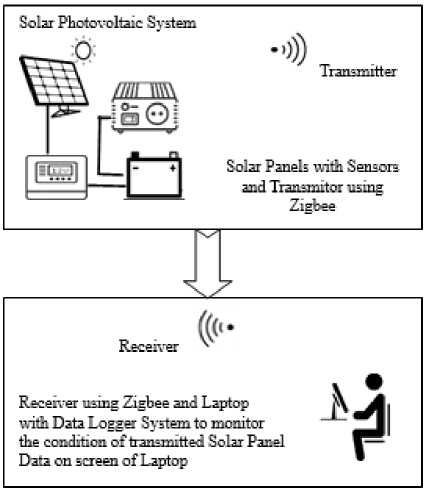
Fig. 1. Showing how to monitor and transmit the condition of solar data using data logger
The generated solar data is stored in excel sheet (.csv format) containing parameter values which can be retrieved later as per convenience to plot the required data graphs in pictorial form offline [29].
-
III. Transferring Of Data Using Qr Codes
QR (Quick response) codes are basically 2D barcodes containing a large amount of data coded in two dimensions (horizontal and vertical direction). They have numerous advantages such as high capacity, reduced size, 360° access, high speed-reading capability and support to many languages (numeric, alpha-numeric, kanji etc) [30]. Maximum of 7089 characters, 4296 alphanumeric characters, 2953 binary bytes and 1817 Kanji characters can be stored in a QR code. The stored information can be shareable link, email, animations, text or digits which can be decoded through a QR code scanner in smart phones. QR code is widely used in many applications like medical, educational, marking etc [31]. The QR code module consists of function pattern region and encoding region. The function pattern region has finder, separator, timing patterns, alignment patterns whereas encoding region has information code words, error correction, and modules to determine the version and type of encoded data. The information is stored in a QR code by coding and retrieved using the process of decoding [32,33]. Since there are several methods to transfer data through wireless means and applications of QR code via mobile phones are increased rapidly due to safe, fast and easy mode of operation [34].
-
IV. Algorithm And Work Done
The transmission of solar data generated by solar photovoltaic system using a new QR code-based technique has several advantages as listed below:
-
❖ Transfer of images, video, audio, text, URL, contact etc
-
❖ Transfer the data anywhere, any time
-
❖ Easy and simple accessing
-
❖ Occupies less space
-
❖ Offline view of real time recorded data
The following fig.2. shows the block diagram of the strategy used for transmission of solar data using QR code in this experiment.
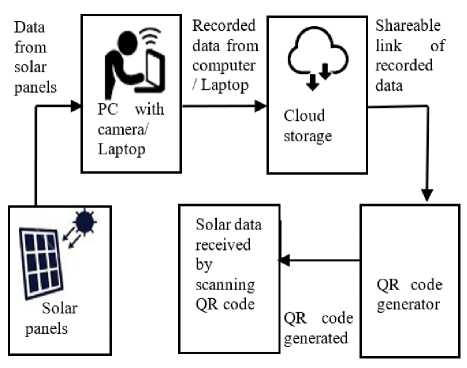
Fig. 2. Shows block diagram of the strategy used for transmission of solar data using QR code
The above fig. 2 explains the complete procedure adopted in transmission of solar data from solar photovoltaic panels to the user through QR code. The data from solar panels is obtained using Zigbee based data acquisition system and is stored in a laptop having internet connectivity. The recorded solar data is stored on cloud storage automatically by google chrome extension and a shareable link is generated corresponding to recorded data file. Now QR code is generated corresponding to the shareable link of stored solar data. By scanning QR code the solar data is successfully retrieved to any other computer, laptop or android mobile phone easily. Some safety features are also included during the accessing process of solar data such as the storing the analytics of the user scanning QR code. The work is performed on standalone solar photovoltaic generation system installed on the roof of Faculty of Engineering, Dayalbagh Educational Institute, and Agra. The standalone solar photovoltaic generation system is connected with a laptop for online monitoring and control of the generated solar data. The standalone solar photovoltaic generation system consists of four solar panels, six long tubular batteries and one solar inverter. In this experiment only the solar data generated by solar panels (output current, output voltage and output power with ambient temperature) is included. The variations in generated graphs and changes in values of output current, output voltage and output power, ambient temperature are recorded as video file. Then further processing for the generation of QR code is adopted using QR code generator. The work done for transmission of solar data is divided into three sections. The first section includes recording of solar data displayed on screen of computer. Second section deals with generation of QR code and its web development. Third section explains with accessing solar data practically.
The name plate rating details of solar panels used in solar photovoltaic system is given below in table 1 and Fig. 3. shows sticker pasted on back of solar panels used in experimental work.

BHARAT HEAVY ELECTRICALS LIMITED, ELECTRONICS DIVISION, BANGALORE, INDIA
тй^а^ шзр
PHOTOVOLTAIC MODULE ТУРЕ No.: LgoaiO
TYPICAL ELECTRICAL SPECIFICATION 1
Peak Power(Pmax)
Open Circuit Voltage (Voc)
Short Circull Current (Ise)
Voltage at peak power point (Vmp) Current at peak power point (Imp) Maximum Over Current Protection/
Series Fuse Rating
Maximum System Voltage
Bypass diode rating (Current)
: 220 Wp : 36.0 V
: 29 V
■ 7.60 A
: 1000 V : 15 A
* For individual module data. pl. refer test report.
Above specifications are at STC : Insolation 1000 W/m\ AMI.5, Cell Temp. 25 C
Fig. 3. Sticker pasted at back of solar panel used in experimental work
The details of laptop used for monitoring and recording solar data are given in table 2.
Table 2. Laptop Details used in Experiment
|
Name |
Details |
|
Windows Edition |
Windows 7 Ultimate Copyright © 2009 Microsoft Corporation Service Pack 1 |
|
Processor |
Intel(R) Core (TM)2 Duo CPU T6600 @ 2.20 GHz |
|
System Type |
32 Bit Operating System |
-
A. Recording of solar data displayed on screen of computer
Zigbee based data acquisition system sends the solar data into laptop which is monitored on its screen using data logger and is stored in video format (.webm) on google drive through google chrome extension. After completion of the recording of solar data, google drive consists of a shareable link which is used in QR code to access the content. The fig. 4., fig. 5. and fig. 6. shows snapshots of solar panels with Zigbee based data acquisition system, laptop with data logger and data logger windows as displayed on the screen of laptop respectively.
Table 1. Name plate rating details of solar panels used in solar photovoltaic system installed on the roof of Faculty of Engineering, Dayalbagh Educational Institute, Agra
|
S. No. |
Name |
Value |
||
|
1. |
Company |
BHEL |
||
|
2. |
Module No. |
L20220 |
||
|
3. |
p maximum |
220 WP |
||
|
Warranted P maximum |
160 WP |
|||
|
V maximum power |
29 V |
|||
|
I maximum power |
7.60 A |
|||
|
4. |
V open circuit |
36 V |
||
|
5. |
I short circuit |
8.3 A |
||
|
6. |
Maximum system voltage |
1000 V |
||
|
7. |
Min. bypass diode rating |
15 A |
||
|
8. |
Maximum series fuse current protection |
15 A |
||
|
9. |
Fire rating class |
C |
||
|
10. |
A. |
Insolation |
1000 W/m2 |
|
|
B. |
STC (Standard test conditions): |
AM |
1.5 spectrum |
|
|
C. |
Cell Temp. |
25 °C |
||
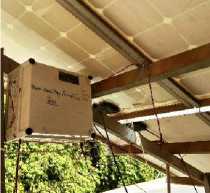
Fig. 4. Solar panels with Zigbee
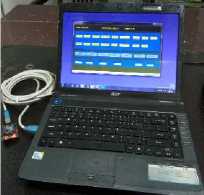
Fig. 5. Laptop used for monitoring and storage of solar panel data
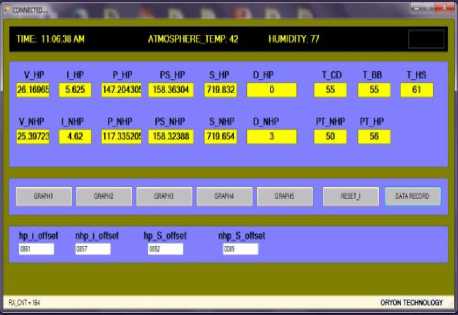
Fig. 6. Snapshot of data logger
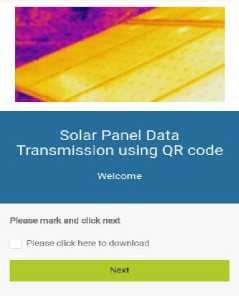
Fig. 9. Welcome window of web application
-
B. Generation of QR code and Developing Web Application
The shareable link from google drive corresponding to the stored solar data is linked with QR code during generation of QR code. An image of solar panel is attached as a logo at the centre of generated QR code for uniqueness. After generation of QR code a content-based web application is developed and generated QR code is attached with it. The following fig. 7. shows the generated QR code having solar data in video format.
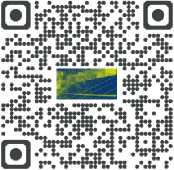
Fig. 7. Generated QR code for solar panel data

Fig. 10. Window with registration form details
-
C. Accessing Solar Panel Data through QR code
Once generation of QR code and development of web application has been completed the solar data is access by scanning the QR code through an android mobile phone with QR code scanner. On scanning the QR code the web application asks for filling up a registration form followed by the downloading the solar panel data. The fig. 8. to fig. 12. shows snapshots of android mobile phone after scanning QR code.
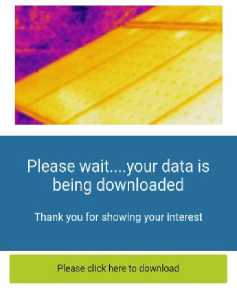
Fig. 11. Window showing about processing of solar panel data
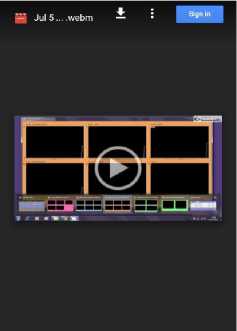
Fig. 12. Window showing solar panel data is downloaded to android mobile phone
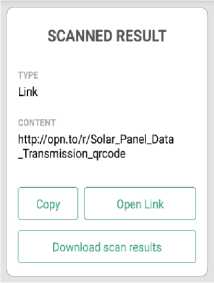
Fig. 8. Snapshot after scanning QR code by android mobile phone
-
V. Results And Discussion
The paper discusses an advance technique which is a blend of solar panel monitoring system with QR code. The research work is performed using free version of google chrome extension which has some limitations on recording duration but the work can be extended for unlimited recording if paid for the service. Similarly, generation of QR code and development of web application is also obtained without using any payment for service. One of the advantages of the technique used in the research work is to view the live variations of solar panel data parameters in video form. By simply scanning a QR code these stored variations can be accessed any time any place. Second advantage of this technique is considerable reduction in size of the storage type i.e., from video format to QR code. At last storage and sharing of solar panel data in QR form is simple and easy to use. The solar panel data can easily be stored and accessed by scanning QR code through the web application. The following table 3. shows detail of recorded video file before and after conversion into QR code.
Table 3. Details of Recorded Video File for Solar Panel Data and Generated QR Code
|
S. No. |
Size |
Format |
Resolution |
|
|
Stored video file |
8.37 MB |
(.webm) |
1280x720 pixels with 30 fps |
|
|
Generated QR code |
43.1 KB |
(.png) |
300x300 pixels |
-
VI. Conclusion
The paper describes an advanced technique for live visualization of pre-stored solar panel data. The variation in graphs for solar panel voltage, current, temperature etc are recorded in video form and visualized in the same manner as they were displayed by data logger on the screen of laptop. Recording of solar panel data is obtained using google chrome extension and stored on google drive therefore there is no need to use additional camera to personal computer or laptop. When solar panel data is stored in QR code i.e., in image form, the size of video file gets reduced from megabytes to kilo bytes which saves the storage area on disk.
Список литературы QR Code Based Solar Panel Data Monitoring System
- Redfield, D., “Solar energy and conversion”, Technology and Society, IEEE Journals and Magazines, vol. 6, no. 23, pp. 4-9, 1978
- Biran, D., Braunstein, A., “Solar radiation and energy measurements”, IEEE Trans. Power Apparatus and Systems, vol. 95, no. 3, pp. 791-794, 1976
- Bouraiou, A., Hamouda, M., Chaker, A., et. al., “Modeling and Simulation of Photovoltaic Module and Array based on One and Two Diode Model Using Matlab/Simulink”, Int. Conf. Technologies and Materials for Renewable Energy, Environment and Sustainability, Elsevier, Energy Procedia, vol. 74, pp. 864-877, 2015.
- Machado Neto, L.D.B., Cabral, C.V.T., Oliveira Filho, D., et. al., “Monitoring of Photovoltaic Systems for Performance Evaluation and Fault Identification”, 2004 IEEE/PES Transmission & Distribution Conference & Exposition: Latin America, Sao Paulo, Brazil, pp. 360-365, 2004
- Ali, M.H., Rabhi, A., Hajjaji, A.E., et. al., “Real Time Fault Detection in Photovoltaic Systems”, 8th Int. Conf. Sustainability in Energy and Buildings, SEB-16, Turin, Italy, Energy Procedia, Elsevier, vol. 111, pp. 914-923, 2017
- Dubey, S., Sarvaiya, J.N., Seshadri, B., “Temperature Dependent Photovoltaic (PV) Efficiency and Its Effect on PV Production in the World A Review”, PV Asia Pacific Conference, Energy Procedia, Elsevier, vol. 32, pp. 311-321, 2013
- Torres, J.P.N., Nashih, S.K., Fernandes, C.A.F., et. al., “The effect of shading on photovoltaic solar panels”, J. Energy Systems, Springer, vol. pp. 1-14, 2016
- Chaudhary, A.S., Chaturvedi, D.K., “Observing Hotspots and Power Loss in Solar Photovoltaic Array Under Shading Effects Using Thermal Imaging Camera”, Int. J. Electrical Machines and Drives, vol. 3, no. 1, pp. 15-23, 2017
- Chaturvedi, D.K., Chaudhary, A.S., “Condition Monitoring of Solar Photovoltaic Panels using Infrared Thermography”, Smart Energy, Genesis Info-Media, vol. 4, no. 3, pp. 34-36, 2017
- Dhoke, A., Sharma, R., Saha, T.K., “Condition Monitoring of a Large-scale PV Power Plant in Australia”, IEEE Conf. Power and Energy Society General Meeting, (PESGM), Boston, MA, USA, 2016
- Kim, H.J., Lee, J.H., Baekc,D.H., et. al., “A Study on Thermal Performance of Batteries using Thermal Imaging and Infrared Radiation”, Journal of Industrial and Engineering Chemistry, Elsevier, vol. 45, no. 25, pp. 360–365, 2017
- Anwari, M., Dom, M.M, Rashid, M. I. M., “Small Scale PV Monitoring System Software Design”, ICSGCE Chengdu, China, Energy Procedia, Elsevier, vol. 12, pp. 586–592, 2011
- Petrescu, C., Lupu, C., Tudor, F.S., et. al., “Data Acquisition System for Recording of Photovoltaic Panel Power”, 2nd IEEE, Int. Conf. Systems and Computer Science (ICSCS), Villeneuve d'Ascq, France, pp. 26-27, 2013
- Purwadi, A., Haroen, Y., Ali, F.Y., “Prototype Development of a Low Cost Data Logger for PV Based LED Street Lighting System”, IEEE, Int. Conf. Electrical Engineering and Informatics, Bandung, Indonesia, pp. 1-5, 2011
- Asif, M., Ali, M., Ahmad, N., et. al., “Design and Development of a Data Logger Based on IEEE 802.15.4/ZigBee and GSM”, Proceedings of the Pakistan Academy of Sciences, A. Physical and Computational Sciences, vol. 53, no. 1, pp. 37–48, 2016
- Painjane, P., Nangare, R., Pardeshi, A, “Design of Solar Insolation Level Detector and Data Logger”, Int. J. Current Engineering and Technology, INPRESSCO, Int. Press Corporation, vol. 4, no. 3, pp. 2803-2807, 2014
- Malagond, G., Bagewadi, G., Pooja, L., et. al., “Design and Development of Data Logger for Standalone SPV Systems”, Int. J. of Emerging Technology and Advanced Engineering, vol. 5, no. 5, pp. 162-166, 2015
- Sehgal, V.K., Nitin, Chauhan, D.S., “Smart Wireless Temperature Data Logger Using IEEE 802.15.4/ZigBee Protocol”, 2008 IEEE Region 10 Conference, TENCON, Hyerabad, India, 2009
- Katsioulis, V., Karapidakis, E., Hadjinicolaou, M., et. al., “Wireless Monitoring and Remote Control of PV Systems Based on the ZigBee Protocol”, Int. Federation for Information Processing (IFIP) Advances in Information and Communication Technology, Springer, vol. 349, pp. 297–304, 2011.
- Shariff, F., Rahim, N.A., Ping, H.W., “Zigbee-Based Data Acquisition System for Online Monitoring of Grid-Connected Photovoltaic System”, J. Expert Systems with Applications, Elsevier, vol. 42, pp. 1730-1742, 2015
- Kazemian, H.B., “An Intelligent Video Streaming Technique in ZigBee Wireless”, IEEE Int. Conf. Fuzzy Systems, FUZZ-IEEE, Jeju Island, South Korea, pp. 121-126, 2009
- Lien, S.F.,Wang, C.C., Su, J.P., et. al., “Logistical Remote Association Repair Framework Using Smartphones Based on the Android Platform”, IEEE 2014 Int. Symposium Computer, Consumer and Control, Taichung, Taiwan, pp. 1191-1194, 2014
- Rajeev, A., Sundar, K.S., “Design of an Off-Grid PV System for the Rural Community”, IEEE 2013 Int. Conf. Emerging Trends in Communication, Control, Signal Processing & Computing Applications (C2SPCA), Bangalore, India, 2013
- Mohammed, A.Y., Mohammed, F.I., Ibrahim, M.Y., “Grid Connected Photovoltaic System”, IEEE, Int. Conf. Communication, Control, Computing and Electronics Engineering (ICCCCEE), Khartoum, Sudan, 2017
- Naeem, M., Anani, N., Ponciano, J., et. al., “Remote Condition Monitoring of a PV System Using an Embedded Web Server”, 2nd IEEE PES Int. Conf. and Exhibition on Innovative Smart Grid Technologies, Manchester, UK, pp. 1-4, 2011
- Stauffer, Y., Ferrario, D., Onillon, E., “Power Monitoring Based Photovoltaic Installation Fault Detection”, 4th IEEE Int. Conf. Renewable Energy Research Application, Palermo, Italy, pp. 199-202, 2015
- Abinayaa, V., Jayan, A., “Case Study on Comparison of Wireless Technologies in Industrial Applications”, Int. J. of Scientific and Research Publications, vol. 4, no. 2, pp. 1-4, 2014
- Gagliarducci, M., Lampasi, D.A., Podesta, L., “GSM-Based Monitoring and Control of Photovoltaic Power Generation”, J. Measurement, Elsevier, vol. 40, no. 3, pp. 314–321, 2007
- Smiadak, D.M., Sözen, M., “Program Development for Monitoring and Analyzing the Data from a Solar PV System”, ASEE North Central Sectional Conference, Pittsburgh, PA, 2010
- Saranya, K., Reminaa, R.S., Subhitsha, S., “Modern Applications of QR-Code for Security”, 2nd IEEE Int. Conf. Engineering and Technology (ICETECH), Coimbatore, TN, India, 2016
- Mohamed, K., SIDI, F., JABAR, M.A., “Protecting Wireless Data Transmission in Mobile Application Systems using Digital Watermarking Technique”, J. Theoretical and Applied Information Technology (JATIT), vol. 83, no. 1, pp. 52-63, 2016
- Liu, Y., Liu, M., “Automatic Recognition Algorithm of Quick Response Code Based on Embedded System”, IEEE Proceedings of the 6th Int. Conf. Intelligent Systems Design and Applications (ISDA'06), Jinan, China, pp. 783-788, 2016
- Gaikwad, A., Singh, K.R., “Information Hiding using Image Embedding in QR Codes for Color Images: A Review”, Int. J. Computer Science and Information Technologies, (IJCSIT), vol. 6, no. 1, pp. 278-283, 2015
- Thiranant, N., Lee, H., “A Design of e-Healthcare Authentication Framework with QR Code”, Int. J. Security and Its Applications, vol. 8, no. 3, pp. 79-86, 2014


